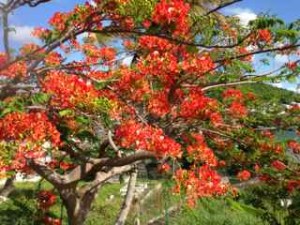In English or in Haitian #Creole, proverbs maketh the language

Deep, wide and of the soil: A kreyol proverb is a bit like Haiti’s passionately red Flamboyant Tree (Photo by Rashmee Roshan Lall)
A proverb is but wisdom distilled and served up with lashings of folksy reality. In English, they follow certain styles:
- alliteration (‘forgive and forget’)
- parallelism (‘nothing ventured, nothing gained)
- rhyme (‘when the cat is away, the mice will play’)
- ellipsis (‘once bitten, twice shy’)
My kreyol is not good enough yet to discern the stylistic features of proverbs here in Haiti, but it seems to me that they have characteristics that rely on assonance (or the repetition of a vowel), hyperbole, paradox and personification.
Here’s my initial list of kreyol proverbs with their equivalent English saying (this is not translation or transliteration):
* Dèyè mòn, gen mòn
More than meets the eye
Literally, of course ‘deye mon, gen mon’ means beyond mountains there are mountains. But it actually refers to unperceived possibilities. My kreyol teacher says it could also mean the Chinese curse ‘may you live in interesting times’.
*Men anpil chay pa lou
Many hands make light work
or
A trouble shared is a trouble halved
* Milat* pòv se nèg, nèg rich se milat.
Clothes maketh the man.
Literally, this kreyol proverb might be seen as hugely politically correct with its many racial references. A poor mulatto is black, a rich black man is a mulatto. But in reality, it refers to the way wealth alters a man’s status, irrespective of colour (or creed?).
* Bon mache koute chè
Penny-wise, pound-foolish
* Grannèg* se lalwa
Might is right


